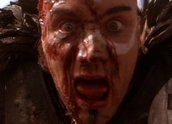


Mad Max 2 (1981)
Synopsis
After a disastrous war over oil, Max (Mel Gibson) has become a desert wanderer with few ties to the world. His family is dead; his only companion is a smart and ferocious blue heeler called ‘dog’. The desert is a realm of motorised gladiators who will kill anyone for petrol. When Max is bushwhacked by the pilot of a gyro-copter (Bruce Spence), the dog turns the tables. The Gyro Captain offers to show Max a place where he can get all the petrol he wants: a desert refinery run by a tribe of settlers. As Max and the Gyro Captain arrive, the fortified refinery is besieged by a murderous gang of vermin led by a giant man in a hockey mask, Lord Humungus (Kjell Nilsson). Max makes a deal with Pappagallo (Mike Preston), leader of the settlers. He will bring them a prime mover for their tanker of petrol, in return for as much gas as he can carry. After the job is done, Max is wounded as he tries to outrun Wez (Vernon Wells), the chief warrior for Lord Humungus. He returns to the fort and joins the settlers, in their last ditch run for freedom. As he drives the tanker out, the Feral Kid (Emil Minty), a small boy who idolises Max, jumps on the back of the truck.
Curator’s notes
The first Mad Max was made fast and cheap, an experience that director George Miller found very frustrating. Its success meant that he was able to make the sequel with much more money and time, and much grander ambitions. The influence of Joseph Campbell – an anthropologist who analysed world mythologies to construct a theory of universal mythology – becomes very evident here. Mad Max 2 is a more self-consciously mythic film, in a much more primal landscape. Max has left the suburbs behind – indeed, we’re not sure they even exist anymore, given the film’s prologue about a disastrous oil war that has ruined the earth. Humanity has reverted to tribalism and the film’s style is similarly reflexive. The desert suggests a savage North Africa, as well as the American west. Humungus’s group clearly model themselves on a variety of late 20th and early 19th century warriors (from highway patrolmen to Mohawk Indians), but the savagery seems more like the Roman empire on wheels. These are like Spartacus’s men without the moral fibre, although Miller is also careful to show that they have deep emotional ties with each other. Wez, the Mohawk warrior who gives us such a shock at the end of clip three is partly driven by a terrible desire for revenge. The Feral Kid (Emil Minty) has killed the love of his life – an effete blonde man called the Golden Youth (played by Jim Brown) – with a metal boomerang. (That’s part of the reason the finale shows Wez trying to get at the Feral Kid).
At the same time, Miller shows us that the good guys aren’t so good. The settlers may dress in homespun clothing and furs, but their leaders are quite willing to doublecross Max at the first opportunity. They clearly regard themselves as morally superior; the film equally clearly shows us their potential for hypocrisy. In the circumstances, Max’s desire not to join them becomes more credible, and laudable. He wishes only to remain independent. The settlers aren’t to be trusted, anymore than Humungus.
The film’s action set pieces were unprecedented in 1981, when the film came out. Miller’s kinetic style of direction, stripped down to the bare essentials, became even more oriented towards speed, energy and cataclysm, albeit with much more attention to the development of character. The film opens and closes with superbly exciting blasts of automotive action. The first is just a taster; the last is a 15-minute extravaganza, a pageant of death that set the standard for this kind of cinema for the next 20 years. It is all achieved without computerised special effects, although Miller uses a lot of traditional effects, even old-fashioned ones like manipulating the film speed.
In the end, Mad Max 2 is about a lot more than speed and mayhem. It’s partly an attempt to make an Australian western, with a strong vernacular flavour (not just an American picture in a different locale); it’s partly an attempt to find universal myths, with universal techniques of storytelling; and it’s partly George Miller’s exploration of the power of cinematic technique, going right back to the silent era. (He has said that the first film was heavily influenced by silent comedy, and particularly the action sequences of Buster Keaton’s great films). As a piece of stylised action cinema, it has no equal. Although some may prefer the less overtly mythic elements of the first film, the second is a much greater spectacle, with a far more nuanced sense of character and human drama.
- Overview
- Curator’s notes
- Video 3 clips
- Principal credits
- Find a copy
- Make a comment
- Map
- Add your review



